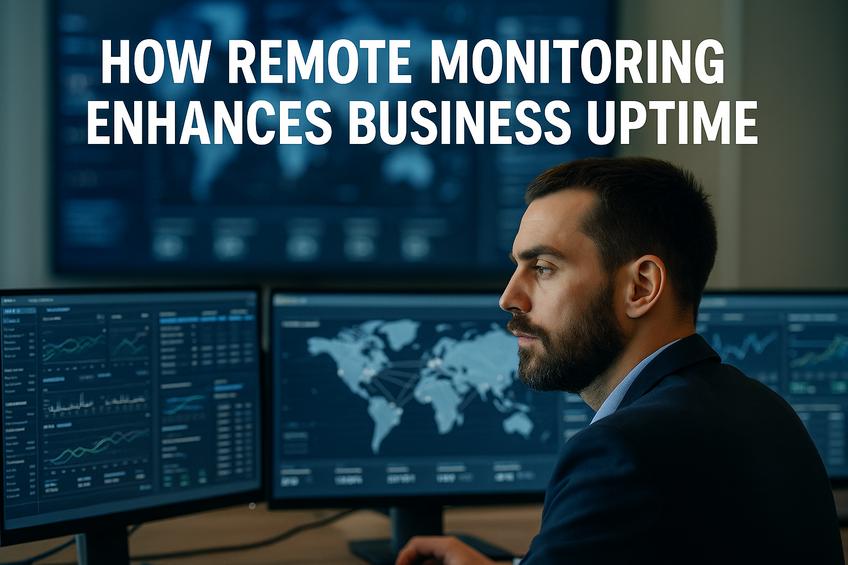Importance of Remote Monitoring in Modern Business
Remote monitoring has become an essential practice for modern businesses, enabling smarter management of IT infrastructure, workforce devices, and network security regardless of physical location. This technology allows organizations to continuously observe and manage their digital environments through specialized software, providing real-time insights and proactive issue resolution. Remote monitoring supports distributed teams by ensuring data security and operational efficiency, especially important as hybrid and remote work models become widespread. For further insight into the role and benefits of remote monitoring in business environments, see the detailed analysis provided by Business.com.
Enhancing Uptime Through Proactive Monitoring
Remote monitoring plays a crucial role in increasing business uptime by enabling proactive oversight and early detection of issues before they escalate into significant problems. By continuously collecting real-time data from systems and infrastructure, remote monitoring allows IT teams and operators to identify performance degradation, potential failures, or security threats promptly. This immediate visibility facilitates timely interventions such as troubleshooting, maintenance, or adjustments without waiting for on-site visits or after a system failure occurs.
Overall, remote monitoring transforms reactive maintenance into proactive management, significantly contributing to higher availability and reliability of business-critical IT services and equipment. This approach not only improves uptime but also ensures cost efficiency by preventing extensive damage and unscheduled outages. Learn more about how proactive monitoring is integrated into comprehensive managed IT services at Barrera's IT Corp.. Additional insights on uptime and system reliability are available in industry analyses such as the Digi blog on industrial remote monitoring benefits.
Operational Efficiency and Resource Management
Remote monitoring offers significant advantages that encourage businesses to adopt this technology for enhanced operational efficiency and resource management. One of the primary benefits is improved efficiency, as remote monitoring allows businesses to track performance and detect issues in real time without the need for physical presence. This immediate insight helps prevent downtime and speeds up problem resolution, saving valuable time and optimizing productivity.
Cost reduction is another key advantage. By implementing remote monitoring, businesses can reduce the need for on-site inspections and manual checks, lowering labor costs and minimizing travel expenses. Additionally, early detection of potential problems through continuous monitoring mitigates the risk of costly repairs or extended outages, which can severely impact revenue and customer trust.
Overall, remote monitoring empowers businesses to operate more smoothly, reduce operational costs, and manage their resources more effectively, making it an indispensable tool in today’s competitive landscape. Learn more about managed IT solutions that incorporate remote monitoring at Barreras IT Corporation.
Real-World Impact of Remote Monitoring
Remote monitoring has proven to be a transformative technology across industries, enabling businesses to improve operational efficiency, reduce downtime, and enhance customer experiences. Here are some real-world examples illustrating successful remote monitoring implementations:
- Healthcare: In telehealth, remote monitoring devices allowed clinicians to track patient vitals and symptoms continuously from their homes. This enabled early intervention, reduced hospital visits, and improved patient outcomes. A case study detailed by The Doctors Company highlights how remote monitoring helped overcome logistical challenges by providing real-time data to healthcare providers, ultimately improving care quality and patient safety Telehealth case study.
- Manufacturing: Remote monitoring of machinery and production lines allows manufacturers to detect potential failures before they cause costly downtime. Sensors collect data on equipment health, temperature, and performance metrics, which IT teams analyze to predict maintenance needs.
- Information Technology: Managed IT service providers use remote monitoring tools to oversee client networks, servers, and devices 24/7. This proactive surveillance enables rapid detection and resolution of issues such as security threats, software failures, or hardware malfunctions. Businesses benefit from minimized disruptions and consistent IT performance. Barrera's IT Corp., for example, offers fully managed IT services that include proactive monitoring, backups, patch management, and cybersecurity, ensuring clients’ infrastructure remains secure and reliable managed IT services.
- Energy Sector: Utilities employ remote monitoring systems for power grids and renewable energy installations. These systems enable real-time status updates, fault detection, and performance optimization from centralized control centers, improving energy distribution reliability and reducing manual inspection costs.
The Future of Remote Monitoring with AI and Predictive Analytics
Advancements in artificial intelligence (AI) and predictive analytics are set to revolutionize remote monitoring capabilities, significantly enhancing business uptime. By integrating AI-driven algorithms with real-time sensor data, organizations can proactively detect anomalies, predict potential failures, and identify patterns before they escalate into operational disruptions.
To explore how managed IT services can incorporate these innovative monitoring technologies, visit our managed hosting solutions page for tailored IT support designed to maximize uptime and reliability. Learn more about the advancements in remote monitoring with AI and analytics from this comprehensive guide by Capella Solutions.
Sources
- Barrera's IT Corp. - Managed IT Service Solutions
- Barrera's IT Corp. - Managed IT Services
- Barreras IT Corporation - Managed IT Solutions
- Barrera's IT Corp. - Managed Hosting Solutions
- Business.com - Remote Monitoring and Management
- Capella Solutions - Remote Monitoring with AI & Analytics: A Step-by-Step Guide
- Digi - Industrial Remote Monitoring Benefits
- The Doctors Company - Telehealth Case Study





